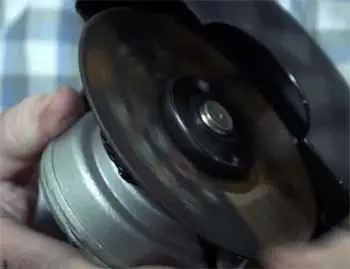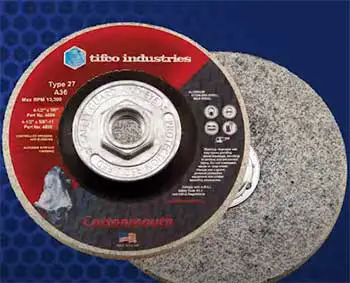The main difference between the two wheels is that type 1 is a flat, disk-shaped wheel that is used mainly for cutting, while type 27 is a saucer-shaped wheel with a depressed center that is mostly used for grinding.
In a wide range of industrial fabrication work and metalworking, an electric grinder is a common power tool for different jobs.
These grinders are fitted with wheels made of abrasive materials for heavy-duty industrial work. The two most commonly used ones are the Type 1 and Type 27 wheels.
A Comparison Table
Type 1 and type 27 are both abrasive wheels that are used on different power tools for a variety of industrial purposes. Other than the aforementioned difference, there are some other notable differences between the two.
If you want to know more about these differences, have a look at the comparison table provided below.
| Factors | Type 1 | Type 27 |
| Material | Ceramic Alumina, Zirconia Alumina, White Aluminium Oxide, and Silicon Carbide. | Ceramic Alumina, Zirconia Alumina, White Aluminium Oxide, and Silicon Carbide. |
| Diameter | 2-4 Inches. | 4-7 Inches. |
| Function | Making precise, 90-degree cuts on tough industrial-grade materials. | Smoothing out cuts, blending in, grinding both corners and flat surfaces. |
| Profile | Straight and flat with a smaller diameter. | Flat but with a depressed center and a larger diameter. |
| Price | Dependent on the material. | Dependent on the material. |
Now, let’s go into a more detailed discussion of all the differentiating factors between the two kinds of wheels.
Key Differences Between Type 1 And Type 27 Wheels
Now that you have looked over the table, you know the basic differences between a type 1 and a type 27 wheel. In this section, we will go more in-depth into the differences between both wheels.
- Materials

Both type 1 and type 27 wheels are used for working with the same kinds of industrial materials.
As such, both wheels are composed of the same kinds of abrasive grains.
These abrasive grains are the part of the wheel that does the actual cutting and grinding.
Some of the most commonly used grains are Ceramic Alumina, Zirconia Alumina, Aluminium Oxide, and Silicon Carbide.
- Function
The function is where the key difference between the two wheel types lies. Type 1 and type 27 wheels may be used in the same fields, but their functions differ greatly.
A type 1 wheel is used by operators to make cuts into different industrial materials, metals, etc. The straight and flat structure of a type 1 wheel allows for deep and precise cuts into the workpiece at 90-degree angles vertically.
Because of its flatness, the wheel provides a larger cutting surface and minimizes interference with the workpiece. However, the flat profile also limits the visibility of the operator.
The main purpose of a type 27 wheel is to grind away material from a workpiece in order to shape and refine it. It can also be used to smooth out cuts and rough edges on a workpiece.
A type 27 wheel can be used on both corners and flat surfaces.
Unlike other wheels that have a flat profile, a type 27 wheel has a sunken or depressed center. This depressed center provides clearance for operators when they are working at constrained angles.
- Diameter & Profile
A type 1 wheel has a diameter between 2-4 inches and has a flat and straight build. It is generally considered the most efficient wheel to use for all-purpose cutting.
The flat structure of a type 1 wheel allows the operator to make deep and precise 90-degree cuts into whatever material they are working on.
A type 27 wheel has a diameter usually between 4-7 and is by far the most common wheel used for grinding purposes. This wheel has a depressed center that allows the operator to grind from a range of different angles.
An operator using a type 27 wheel can work anywhere between 0 to 45 degrees. However, the optimal angle for working with this wheel is between 25 to 30 degrees.
- Pricing
When it comes to the price of either wheel, it is entirely dependent on the manufacturer and the abrasive material that it is made out of.
The price can range from highly affordable to incredibly high based on the grain contained within the wheel. Certain wheels have diamonds in the grain that can greatly raise the price.
Having said all that, rest assured that the typical wheel is well within most people’s budget.
Which Wheel is Better for You?

Although type 1 and type 27 wheels are used in the same line of work and in similar industries, they have very different purposes.
One’s specialty is cutting, while the other is used mostly for grinding.
Therefore, the wheel you should choose depends on the kind of work you plan on doing.
If you require a wheel for all-purpose cutting of different industrial materials, you should go for a type 1 wheel.
On the other hand, if what you need is a wheel capable of easily grinding, shaping, and smoothing out workpieces, a type 27 wheel is the one for you.
Frequently Asked Questions (FAQs)
Below are some frequently asked questions about type 1 and type 27 wheels and their answers.
A type 1 wheel has a straight and flat profile and is most commonly used for cutting. A type 27 wheel has a depressed center and is used mostly for grinding.
It is not recommended that you use type 1 wheels on angle grinders that are specified for type 27 wheels and vice versa.
A type 1 cut-off wheel is an abrasive wheel that is used for making precise 90-degree cuts on different industrial metals.
A type 27 grinding wheel is used for grinding away materials from a workpiece in order to shape and refine it.
Conclusion
In conclusion, both type 1 and type 27 wheels have their own specific functions so there is no better or worse wheel between them. One is used specifically for cutting, while the other’s specialty is grinding.
Therefore, a type 1 vs. type 27 cutting wheel argument does not make sense since they each work very differently. The wheel you ultimately end up choosing will depend entirely on the kind of work you want to accomplish.
